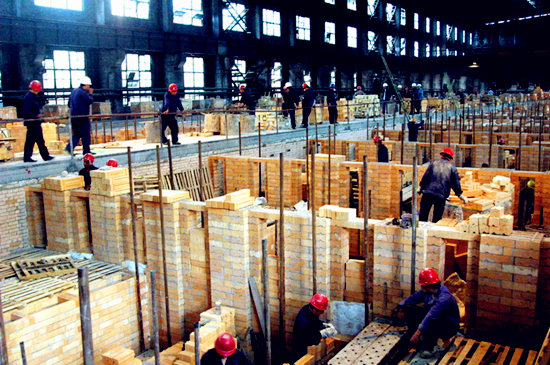There are strict procedures for the construction of refractory materials for industrial kilns. The construction procedures vary from the acceptance before construction to the various processes in the construction process, from various finalized refractory materials to various amorphous refractory materials. Main knowledge points of this article: classification of industrial furnaces; General regulations on process handover; Main work of each stage of industrial furnace construction; Construction procedures for refractory brick masonry; Construction procedure of refractory castable masonry.

1、 Classification of industrial furnaces.
According to industrial use, industrial furnaces can be classified as follows:
- metallurgical furnaces, such as coke oven, iron blast furnace, steel-making converter, electric furnace, etc;
- nonferrous metal industrial furnaces and kilns, such as aluminum electrolytic cell, magnesium electrolytic cell, flash furnace, refining and firing furnace, blast furnace, zinc rectification furnace, etc;
- Petrochemical furnaces and kilns, such as cracking furnace, gasifier, primary reformer, secondary converter, etc;
- building materials industrial kilns, such as rotary kilns, glass kilns, tunnel kilns, etc;
- electric power industrial furnaces, such as power plant boilers;
- other industrial furnaces, such as quenching furnace, tempering furnace, annealing furnace, heating furnace, preheating furnace, steam boiler, continuous and continuous vertical furnace, etc.
2、 General regulations on process handover
The masonry works of industrial furnaces and kilns shall not be constructed until the furnace framework structure and relevant equipment are installed, inspected and qualified, and a handover certificate is signed.
(1) The process handover certificate shall include the following contents
- measurement records of furnace center line and control elevation and necessary settlement observation points;
- acceptance certificate of concealed works;
- pressure test records and welding tightness test certificates of furnace cooling device, pipeline and furnace shell;
- remeasurement records of main dimensions of steel structure, furnace track and other installation positions;
- test run certificate of dynamic furnace or movable part of furnace;
- inspection certificate of position, size and welding quality of brick supporting plate and anchor in furnace;
- protection requirements for the results of the previous process.
(2) Technical requirements for process handover
- during the process handover, the quality inspection and acceptance of the previous process shall be carried out in time and the process handover procedures shall be handled.
- furnace masonry is generally the last process in the industrial furnace system engineering. The inspection and handover of furnace foundation, furnace frame structure and relevant equipment installation is an integral part of strengthening the quality management of system engineering.
3、 Main work at each stage of industrial furnace construction
(1) Main work in construction preparation stage
- technical preparation. Be familiar with and master the joint review of construction drawings and relevant technical data. Preparation of construction scheme, including construction sequence, quality control standards and measures, construction methods for key and difficult points, duration control measures, construction measures in winter and rainy season, construction safety and environmental protection measures, etc.
- resource preparation. Human resources preparation, including management and technical personnel, masonry skilled workers, general workers and special types of work as required. Preparation of construction equipment. Material preparation mainly refers to mobilization of refractory materials by stages and batches and storage by categories.
- construction preparation. Construction site preparation, such as water, power supply, construction site, transportation road, refractory stacking site, processing site and mixing site of castables and slurry. Inspection and measurement of main parts of furnace masonry, determination of starting position and setting out.
(2) Main work of industrial furnace masonry stage
- strengthen technical management and organize construction in strict accordance with construction organization design and construction scheme. The design change, construction records, material substitution and other related technical work shall be confirmed, and the data shall be sorted out and archived.
- strengthen labor organization and management, such as matching the skill level of construction workers, confirmation of work license of special operators, reasonable arrangement of general workers, etc.
- strengthen the management of materials and equipment, such as the use and delivery of refractory materials, reasonable allocation of refractory material deviation, safe operation of various equipment, etc.
- strengthen safety, environmental protection management and civilized construction. Such as dust removal protective articles for construction personnel, dust reduction measures, waste disposal, safety measures for high-altitude operation and cross operation, night construction measures, etc.
- strengthen quality management. Strictly implement self inspection, special inspection and joint inspection systems, and make construction inspection records and acceptance of divisional and subdivisional works.
- strengthen progress management and organize construction in strict accordance with the operation schedule.
4、 Construction procedure of refractory brick masonry
(1) Construction procedure of dynamic furnace
- dynamic furnace masonry can only be carried out after the no-load test run of single furnace is qualified and accepted.
- basic sequence of masonry:
Starting point selection (from the hot end to the cold end or from the low end to the high end) → sectional operation marking → brick selection (select refractory bricks of different specifications and materials according to the use position and working temperature) → brick matching (match brick types according to different deviation sizes of the same type of bricks) → if there are anchor nails or brick supporting plates, the anchor nails and brick supporting plates shall be welded → if there is a thermal insulation layer (such as silicon wool plate), the thermal insulation layer shall be laid before masonry → if it is wet masonry, Before masonry, the mortar shall be prepared first (the performance of the mortar shall match the refractory bricks) → masonry by sections → brick repair and locking by sections → reservation and filling of expansion joints.
For example, during the masonry of rotary kiln, the circular masonry shall be carried out in several sections from the hot end to the cold end, and the length of each section shall be no more than 1m for wet masonry and no more than 2T for dry masonry. If the bricklaying machine is used for bricklaying, it is not necessary to rotate the kiln shell, and each ring of bricks can be completed at one time; If the top rod pressing brick is used for masonry, when each ring of bricks is built from the bottom to both sides at the same time to a semicircle, the top rod is used to press the laid refractory bricks, and then the rotary kiln shell continues to be built after 90 degrees, and then the top rod is used to press, and then the shell is rotated and cracked again after 90 degrees, and the masonry continues until the ring lock brick is completed and the masonry of this section is completed.
(2) Construction procedure of static furnace
The construction procedure of static furnace is basically the same as that of dynamic furnace. The differences are as follows:
- masonry can be carried out without no-load test run;
- the masonry sequence must be from bottom to top;
- no matter which masonry method is adopted, each ring of bricks can be completed at one time;
- the arched part shall be built from both sides to the middle, and the arch tire shall be used for pressing and fixing. After the brick locking is completed, the arch tire shall be removed.
(3) Main work in oven drying stage
Make baking plan for industrial furnace; Prepare tools, machines and materials for oven drying; Confirm oven drying curve; Prepare operation plan and emergency response plan during furnace drying; Determine and implement key monitoring points during oven drying.
5、 Construction procedure of refractory castable masonry
Material inspection and acceptance → construction surface cleaning → anchor nail welding → formwork fabrication and installation → waterproof agent painting → pouring material mixing and making test block → pouring and vibrating → formwork removal → expansion joint reservation and filling → finished product curing.


 Wechat Us
Wechat Us